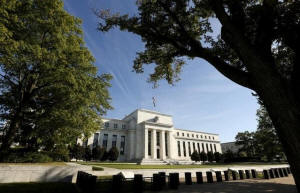|
With rate hike in the bag, focus turns to
Fed's policy language
 Send a link to a friend
Send a link to a friend
 [June 12, 2018]
By Howard Schneider [June 12, 2018]
By Howard Schneider
WASHINGTON (Reuters) - With the Federal
Reserve virtually guaranteed to raise interest rates this week,
investors are focused on how the U.S. central bank characterizes its
monetary policy as borrowing costs return to more normal levels amid an
ongoing economic expansion.
In what could be the most consequential rewrite of its policy statement
in two-and-a-half years, the Fed may signal how close it is to stopping
its rate hike cycle, whether faster economic growth warrants ramping up
the pace of tightening, and if it feels the era of loose money is, in
effect, over.
The language in the Fed policy statement "is growing increasingly stale
with each successive rate hike," Goldman Sachs economists Spencer Hill
and Jan Hatzius wrote ahead of the start on Tuesday of the central
bank's two-day policy meeting.
Hatzius predicted the policy-setting Federal Open Market Committee will,
at the least, drop language it has used since late 2015 that says rates
would remain below historical levels "for some time" to come.
That small change would mark a broad acknowledgement that, nine years
into the second-longest U.S. economic expansion on record, monetary
policy and the economy in general are starting to look increasingly
normal, both domestically and abroad.

The Fed's current monetary policy tightening cycle began in December
2015, and it has started trimming the massive portfolio of U.S. Treasury
bonds and mortgage-backed securities that it bought to boost the economy
after the 2007-2009 recession.
The European Central Bank is expected later this week to outline its own
plans to stop emergency asset purchases, highlighting Europe's rebound
from crisis.
Global growth has remained strong this year despite the risk of a global
trade war and concerns about rising levels of sovereign debt.
Set against that backdrop, it makes little sense, say many analysts, for
the Fed to keep promising to keep rates low as borrowing costs hit
levels that are no longer considered low on an historic basis.
The Fed's benchmark overnight lending rate, if lifted to a range of 1.75
percent to 2 percent this week, would be at a level comparable or above
where it was from late 2001 to 2004, a period punctuated by the bursting
of the technology bubble and the Sept. 11, 2001 attacks.
The Fed's policy statement and fresh economic projections are due to be
released at 2 p.m. EDT (1800 GMT) on Wednesday. Fed Chairman Jerome
Powell is scheduled to hold a press conference half an hour later.
"We see hawkish overtones from the decision to raise rates and our
expectation that the statement will no longer say that the (federal)
funds rate is likely to remain below the long-run neutral rate for some
time," Barclays analyst Michael Gapen wrote in a recent research note.
[to top of second column]
|

The Federal Reserve headquarters in Washington, U.S., September 16,
2015. REUTERS/Kevin Lamarque/File Photo

"As the (Federal Open Market Committee) closes in on neutral, we see
it as less likely to make promises on the path of policy," Gapen
said, referring to the level at which monetary policy neither boosts
nor slows the economy.
ACCOMMODATIVE OR NOT
Futures contracts indicate a 96 percent probability the fed funds
rate will be raised a quarter of a percentage point on Wednesday,
according to CME Group.
Fed policymakers' updated forecasts will show whether they continue
to expect only one additional rate increase over the rest of the
year, or feel recent strong job and economic data justify a second
one in the near term, and perhaps a boost to the number of rate
hikes expected next year.
The U.S. central bank raised rates in March and policymakers say
they expect two more upward moves before the end of the year. The
Fed raised rates three times last year.
For several weeks, Fed officials have been indicating that changes
to the statement may be in the works, though they have not been
clear about the likely extent of them.
According to the minutes from the last policy meeting and
policymakers' statements since then, some Fed officials feel the fed
funds rate is already at or near "neutral," and therefore should no
longer be described as "accommodative," or directly encouraging
investment and spending.
Analysts see such a shift as less likely at this point.
The last time such a change occurred was in September 2005 when
rates were raised from 3.50 percent to 3.75 percent, "into the range
of (neutral) estimates" given by Fed staff at the time, Goldman
Sachs analysts noted.
The phrase "policy remains accommodative" was merely removed, with
no substitute language or explanation.

Currently, the core of Fed policymakers feel the neutral rate is
around 2.9 percent - allowing leeway for perhaps three or four more
rate increases - and some argue it may well be rising given the
impact of the Trump administration's tax cuts and other fiscal
stimulus.
(Reporting by Howard Schneider; Editing by Paul Simao)
[© 2018 Thomson Reuters. All rights
reserved.]
Copyright 2018 Reuters. All rights reserved. This material may not be published,
broadcast, rewritten or redistributed.
Thompson Reuters is solely responsible for this content. |